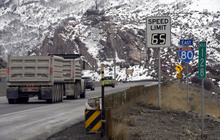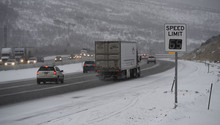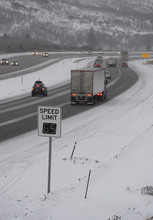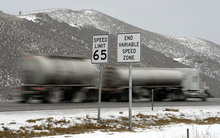This is an archived article that was published on sltrib.com in 2014, and information in the article may be outdated. It is provided only for personal research purposes and may not be reprinted.
The speed limit on Interstate 80 in Parleys Canyon will not necessarily be 65 mph anymore. Sometimes it now may be as low as 35 mph or maybe somewhere in between
The Utah Department of Transportation on Wednesday will turn on a new $750,000 electronic sign system that will allow engineers to adjust the speed limit during storms or icy weather. UDOT removed the regular speed limit signs on Tuesday.
"Its whole aim is to improve safety and the consistency of flow in Parleys Canyon during weather events," said Robert Miles, UDOT Region 2 East District engineer. "We're excited about it. We think we can really affect the safety and capacity of the roadway."
During regular sunny days, he said, the speed limit will remain at 65 mph.
But during bad weather, a traffic engineer will look at data from road sensors that show how slick the road is, along with the canyon's temperature and humidity. Other data will show how fast traffic is moving, and cameras can show how good visibility is.
After taking all those factors into consideration, the traffic engineer will remotely alter the speed limit signs – and send alerts to the Utah Highway Patrol. "It becomes the enforceable speed limit," Miles said.
The system will operate on I-80 from the mouth of Parleys Canyon to near the Jeremy Ranch exit. Eight electronic signs are in eastbound lanes, and seven in westbound lanes.
"This is the first such system in Utah. There are others operating in Nevada and Colorado. Wyoming and Washington have them on the Interstate system in areas much like Parleys," Miles said.
UDOT chose to build the state's first system in Parleys because of sometime treacherous weather there, Miles said, plus, "there is a lot of traffic, and we have the infrastructure to support it" including connections to computer networks, road sensors and electricity for the signs.
UDOT has been testing software and hardware for the system for several months.
If it works well "we'll take a look at this at other locations, maybe Sardine Canyon [near Logan] or Provo Canyon," and other sites have also been discussed, Miles said. "This is a good tool to affect safety."









